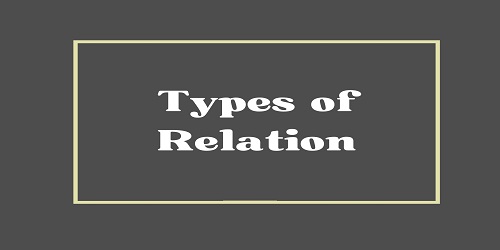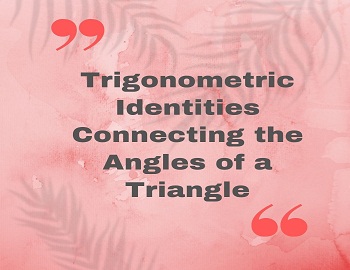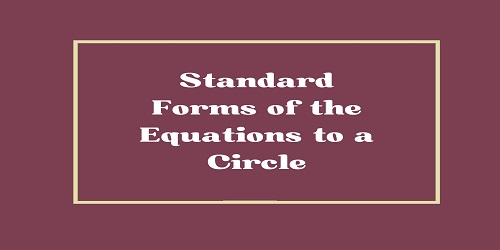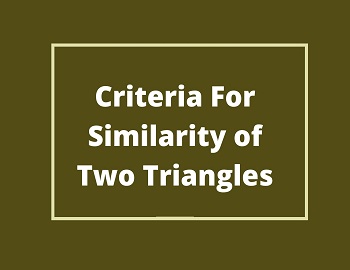Types of Relation:
(1) Identity Realtion- Relation R on a set A defined as {(a, a) ∀ a ∈ A} is said to be an identity relation on set A and is denoted by IA.
For example- If A = {1, 2, 3} then IA = {(1, 1) (2, 2) (3, 3)}
(2) Reflexive Relation- A relation R on a set A is said to be reflexive if every element of A is related to itself i.e. R is reflexive ⇔ (iff) aRa ∀ a ∈ A. Considering the set A = {a, b, c, d}, if any one of the ordered pairs (a, a) (b, b) (c, c) (d, d) is absent in the relation R, then the relation cannot be reflexive.
For example- If A = {1, 2, 3} and R = {(1, 1) (1, 2) (2, 2) (3, 2) (3, 3)} then R is reflexive.
The universal relation on a non-void set is reflexive. The identity relation on a non-void set is always reflexive but a reflexive relation is not necessarily an identity relation.
Let A = set of lines in a plane and then the relation R is defined by a1Ra2 iff a1 || a2 is reflexive because every line is parallel to itself.
(3) Symmetric Relation- A relation R on a set A is said to be symmetric iff (a, b) ∈ R ⇒ (b, a) ∈ R.
For example- If A = {1, 2, 3} and R = {(1, 1) (1, 2) (2, 1) (3, 3)} then R is symmetric.
Let A = set of lines in a plane, then the relation R is defined by a1Ra2 iff a1 || a2 is symmetric because if a1 || a2 ⇒ a2 || a1.
The identity and the universal relations on a non-empty set A are symmetric relations on A.
(4) Transitive Relation- A relation R on a set A is said to be transitive iff (a, b) ∈ R, (b, c) ∈ R ⇒ (a, c) ∈ R. Let A be the set of natural numbers and a relation R on a set A is defined by aRb iff a divides b is transitive because if a divides b and b divides c then a divides c.
The identity and the universal relations on a non-empty set are transitive.
(5) Equivalence Relation- A relation R on a set A is said to be an equivalence relation if-
- R is reflexive.
- R is symmetric.
- R is transitive.
| Example- Three relations R1, R,2, and R3 are defined on set A = {-1, 0, 1} as follows: (i) R1 = {(-1, -1), (0, 0), (1, 1)} (ii) R2 = {(-1, 0), (0, 1), (1, -1), (0, -1), (1, 0), (-1, 1)} (iii) R3 = {(0, 0), (1, 1), (0, 1), (1, 0)} Find which of the relations on A is reflexive, symmetric, or transitive. Solution- (i) R1 is reflexive because of a ∈ A ⇒ (a, a) ∈ R. (ii) R2 and R3 are symmetric. (iii) R3 is transitive. |
| Example- Let R be a relation on the set I of all integers defined as (x, y) ∈ R ⇔ x – y is divisible by n. Prove that R is an equivalence relation. Solution- R is reflexive: ∀ x ∈ I, x – x = 0, which is divisible by n. ∴ (x, x) ∈ R ∴ R is reflexive. R is symmetric: Suppose (x, y) ∈ R ⇒ x – y is divisible by n. ⇒ x – y = nλ ⇒ – (y – x) = nλ ⇒ (y – x) = n (-λ) ⇒ (y – x) = nµ ⇒ (y – x) is divisible by n ⇒ (y, x) ∈ R ∴ R is symmetric. R is transitive: Suppose (x, y) and (y, z) ∈ R. ⇒ x – y is divisible by n and y – z is divisible by n. ⇒ x – y = nλ and y – z = nµ ⇒ y = x – nλ ……….(i) and y = z + nµ ……….(ii) From (i) and (ii): x – nλ = z + nµ ⇒ x – z = nλ + nµ ⇒ x – z = n (λ + µ) ⇒ x – z = np ⇒ x – z is divisble by n ⇒ (x, z) ∈ R ∴ R is transitive. Thus R is an equivalence relation. |









Comments (No)